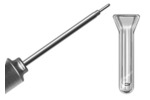- ▶
- Heaters/Source
- ▶
- Agilent Heaters and SensorsMass Spectrometry, Scientific Supplies & ManufacturingScientific Instrument Services 5973 Source Heater Tamper Resistant Allen Wrench 5973/5975 Quad Sensor 5985 Source Heater Assembly Agilent Interface Heater Assembly 5971 Interface Heater

- ▶
- Probes
- LiteratureApplication Notes Adsorbent Resins Guide Mass Spec Tips SDS Sheets FAQ MS Calibration Compound Spectra Manuals MS Links/Labs/ Organizations MS Online Tools Flyers on Products/Services Scientific Supplies Catalog About Us NextAdvance Bullet Blender® Homogenizer Protocols Micro-Mesh® Literature Instrumentation Literature Agilent GC/MS Literature SIS News / E-Mail Newsletter NIST MS Database - Update Notifications

- ▶
- Application NotesNote 103: EPA Method 325B, Novel Thermal Desorption Instrument Modification to Improve Sensitivity Note 102: Identification of Contaminants in Powdered Beverages by Direct Extraction Thermal Desorption GC/MS Note 101: Identification of Contaminants in Powdered Foods by Direct Extraction Thermal Desorption GC/MS Note 100: Volatile and Semi-Volatile Profile Comparison of Whole Versus Cracked Versus Dry Homogenized Barley Grains by Direct Thermal Extraction Note 99: Volatile and Semi-Volatile Profile Comparison of Whole vs. Dry Homogenized Wheat, Rye and Barley Grains by Direct Thermal Extraction GC/MS Note 98: Flavor and Aroma Profiles of Truffle Oils by Thermal Desorption GC/MS Note 97: Flavor Profiles of Imported and Domestic Beers by Purge & Trap Thermal Desorption GC/MS Note 96: Reducing Warping in Mass Spectrometer Filaments, with SISAlloy® Yttria/Rhenium Filaments Note 95: Detection of Explosives on Clothing Material by Direct and AirSampling Thermal Desorption GC/MS Note 94: Detection of Nepetalactone in the Nepeta Cataria Plant by Thermal Desorption GC/MS Note 93: Detection of Benzene in Carbonated Beverages with Purge & Trap Thermal Desorption GC/MS Note 92: Yttria Coated Mass Spectrometer Filaments Note 91: AutoProbe DEP Probe Tip Temperatures Note 90: An Automated MS Direct Probe for use in an Open Access Environment Note 89: Quantitation of Organics via a Mass Spectrometer Automated Direct Probe Note 88: Analysis of Silicone Contaminants on Electronic Components by Thermal Desorption GC-MS Note 87: Design and Development of an Automated Direct Probe for a Mass Spectrometer Note 86: Simulation of a Unique Cylindrical Quadrupole Mass Analyzer Using SIMION 7.0. Note 85: Replacing an Electron Multiplier in the Agilent (HP) 5973 MSD Note 84: Vacuum Pump Exhaust Filters - Charcoal Exhaust Traps Note 83: Vacuum Pump Exhaust Filters - Oil Mist Eliminators Note 82: Vacuum Pump Exhaust Filters Note 81: Rapid Bacterial Chemotaxonomy By DirectProbe/MSD Note 80: Design, Development and Testing of a Microprocessor ControlledAutomated Short Path Thermal Desorption Apparatus Note 79: Volatile Organic Compounds From Electron Beam Cured and Partially Electron Beam Cured Packaging Using Automated Short Path Thermal Desorption Note 78: A New Solution to Eliminate MS Down-Time With No-Tool-Changing of Analytical GC Columns Note 77: The Determination of Volatile Organic Compounds in VacuumSystem Components Note 76: Determination of the Sensitivity of a CRIMS System Note 75: An Apparatus for Sampling Volatile Organics From LivePlant Material Using Short Path Thermal Desorption Note 74: Examination of Source Design in Electrospray-TOF Using SIMION 3D Note 73: The Analysis of Perfumes and their Effect on Indoor Air Pollution Note 72: 1998 Version of the NIST/EPA/NIH Mass Spectral Library, NIST98 Note 71: Flavor Profile Determination of Rice Samples Using Shor tPath Thermal Desorption GC Methods Note 70: Application of SIMION 6.0 To a Study of the Finkelstein Ion Source: Part II Note 69: Application of SIMION 6.0 To a Study of the Finkelstein Ion Source: Part 1 Note 68: Use of a PC Plug-In UV-Vis Spectrometer To Monitor the Plasma Conditions In GC-CRIMS Note 67: Using Chemical Reaction Interface Mass Spectrometry (CRIMS) To Monitor Bacterial Transport In In Situ Bioremediation Note 66: Probe Tip Design For the Optimization of Direct Insertion Probe Performance Note 65: Determination of Ethylene by Adsorbent Trapping and Thermal Desorption - Gas Chromatography Note 64: Comparison of Various GC/MS Techniques For the Analysis of Black Pepper (Piper Nigrum) Note 63: Determination of Volatile and Semi-Volatile Organics in Printer Toners Using Thermal Desorption GC Techniques Note 62: Analysis of Polymer Samples Using a Direct Insertion Probe and EI Ionization Note 61: Analysis of Sugars Via a New DEP Probe Tip For Use With theDirect Probe On the HP5973 MSD Note 60: Programmable Temperature Ramping of Samples Analyzed ViaDirect Thermal Extraction GC/MS Note 59: Computer Modeling of a TOF Reflectron With Gridless Reflector Using SIMION 3D Note 58: Direct Probe Analysis and Identification of Multicomponent Pharmaceutical Samples via Electron Impact MS Note 57: Aroma Profiles of Lavandula species Note 56: Mass Spec Maintenance & Cleaning Utilizing Micro-Mesh® Abrasive Sheets Note 55: Seasonal Variation in Flower Volatiles Note 54: Identification of Volatile Organic Compounds in Office Products Note 53: SIMION 3D v6.0 Ion Optics Simulation Software Note 52: Computer Modeling of Ion Optics in Time-of-Flight mass Spectrometry Using SIMION 3D Note 51: Development and Characterization of a New Chemical Reaction Interface for the Detection of Nonradioisotopically Labeled Analytes Using Mass Spectrometry (CRIMS) Note 50: The Analysis of Multiple Component Drug Samples Using a Direct Probe Interfaced to the HP 5973 MSD Note 49: Analysis of Cocaine Utilizing a New Direct Insertion Probe on a Hewlett Packard 5973 MSD Note 48: Demonstration of Sensitivity Levels For the Detection of Caffeine Using a New Direct Probe and Inlet for the HP 5973 MSD Note 47: The Application Of SIMION 6.0 To Problems In Time-of-Flight Mass Spectrometry Note 46: Delayed Extraction and Laser Desorption: Time-lag Focusing and Beyond Note 45: Application of SIMION 6.0 to Filament Design for Mass Spectrometer Ionization Sources Note 44: The Design Of a New Direct Probe Inlet For a Mass Spectrometer Note 43: Volatile Organic Composition In Blueberries Note 42: The Influence of Pump Oil Purity on Roughing Pumps Note 41: Hydrocarbon Production in Pine by Direct Thermal Extraction Note 40: Comparison of Septa by Direct Thermal Extraction Note 39: Comparison of Sensitivity Of Headspace GC, Purge and Trap Thermal Desorption and Direct Thermal Extraction Techniques For Volatile Organics Note 38: A New Micro Cryo-Trap For Trapping Of Volatiles At the Front Of a GC Capillary Column Note 37: Volatile Organic Emissions from Automobile Tires Note 36: Identification Of Volatile Organic Compounds In a New Automobile Note 35: Volatile Organics Composition of Cranberries Note 34: Selection Of Thermal Desorption and Cryo-Trap Parameters In the Analysis Of Teas Note 33: Changes in Volatile Organic Composition in Milk Over Time Note 32: Selection and Use of Adsorbent Resins for Purge and Trap Thermal Desorption Applications Note 31: Volatile Organic Composition in Several Cultivars of Peaches Note 30: Comparison Of Cooking Oils By Direct Thermal Extraction and Purge and Trap GC/MS Note 29: Analysis Of Volatile Organics In Oil Base Paints By Automated Headspace Sampling and GC Cryo-Focusing Note 28: Analysis Of Volatile Organics In Latex Paints By Automated Headspace Sampling and GC Cryo-Focusing Note 27: Analysis of Volatile Organics In Soils By Automated Headspace GC Note 26: Volatile Organics Present in Recycled Air Aboard a Commercial Airliner Note 25: Flavor and Aroma in Natural Bee Honey Note 24: Selection of GC Guard Columns For Use With the GC Cryo-Trap Note 23: Frangrance Qualities in Colognes Note 22: Comparison Of Volatile Compounds In Latex Paints Note 21: Detection and Identification Of Volatile and Semi-Volatile Organics In Synthetic Polymers Used In Food and Pharmaceutical Packaging Note 20: Using Direct Thermal Desorption to Assess the Potential Pool of Styrene and 4-Phenylcyclohexene In Latex-Backed Carpets Note 19: A New Programmable Cryo-Cooling/Heating Trap for the Cryo-Focusing of Volatiles and Semi-Volatiles at the Head of GC Capillary Columns Note 18: Determination of Volatile Organic Compounds In Mushrooms Note 17: Identification of Volatile Organics in Wines Over Time Note 16: Analysis of Indoor Air and Sources of Indoor Air Contamination by Thermal Desorption Note 14: Identification of Volatiles and Semi-Volatiles In Carbonated Colas Note 13: Identification and Quantification of Semi-Volatiles In Soil Using Direct Thermal Desorption Note 12: Identification of the Volatile and Semi-Volatile Organics In Chewing Gums By Direct Thermal Desorption Note 11: Flavor/Fragrance Profiles of Instant and Ground Coffees By Short Path Thermal Desorption Note 10: Quantification of Naphthalene In a Contaminated Pharmaceutical Product By Short Path Thermal Desorption Note 9: Methodologies For the Quantification Of Purge and Trap Thermal Desorption and Direct Thermal Desorption Analyses Note 8: Detection of Volatile Organic Compounds In Liquids Utilizing the Short Path Thermal Desorption System Note 7: Chemical Residue Analysis of Pharmaceuticals Using The Short Path Thermal Desorption System Note 6: Direct Thermal Analysis of Plastic Food Wraps Using the Short Path Thermal Desorption System Note 5: Direct Thermal Analysis Using the Short Path Thermal Desorption System Note 4: Direct Analysis of Spices and Coffee Note 3: Indoor Air Pollution Note 2: Detection of Arson Accelerants Using Dynamic Headspace with Tenax® Cartridges Thermal Desorption and Cryofocusing Note 1: Determination of Off-Odors and Other Volatile Organics In Food Packaging Films By Direct Thermal Analysis-GC-MS Tech No. "A" Note 14: Elimination of "Memory" Peaks in Thermal Desorption Improving Sensitivity in the H.P. 5971 MSD and Other Mass Spectrometers - Part I of II Improving Sensitivity in the H.P. 5971 MSD and Other Mass Spectrometers- Part II of II Adsorbent Resins Guide Development and Field Tests of an Automated Pyrolysis Insert for Gas Chromatography. Hydrocarbon Production in Pine by Direct Thermal Extraction A New Micro Cryo-Trap for the Trapping of Volatiles at the Front of a GC Capillary (019P) - Comparison of Septa by Direct Thermal Extraction Volatile Organic Composition in Blueberry Identification of Volatile Organic Compounds in Office Products Detection and Indentification of Volatiles in Oil Base Paintsby Headspace GC with On Column Cryo-Trapping Evaluation of Septa Using a Direct Thermal Extraction Technique INFLUENCE OF STORAGE ON BLUEBERRY VOLATILES Selection of Thermal Desorption and Cryo-Trap Parameters in the Analysis of Teas Redesign and Performance of a Diffusion Based Solvent Removal Interface for LC/MS The Design of a New Direct Probe Inlet for a Mass Spectrometer Analytes Using Mass Spectrometry (CRIMS) Application of SIMION 6.0 to Filament Design for Mass Spectrometer Ionization Sources A Student Guide for SIMION Modeling Software Application of SIMION 6.0 to Problems in Time-of-flight Mass Spectrometry Comparison of Sensitivity of Headspace GC, Purge and TrapThermal Desorption and Direct Thermal Extraction Techniques forVolatile Organics The Influence of Pump Oil Purity on Roughing Pumps Analysis of Motor Oils Using Thermal Desorption-Gas Chromatography-Mass Spectrometry IDENTIFICATION OF VOLATILE ORGANIC COMPOUNDS IN PAPER PRODUCTS Computer Modeling of Ion Optics in Time-of-Flight mass Spectrometry using SIMION 3D Seasonal Variation in Flower Volatiles Development of and Automated Microprocessor Controlled Gas chromatograph Fraction Collector / Olfactometer Delayed Extraction and Laser Desorption: Time-lag Focusing and Beyond A New Micro Cryo-Trap for the Trapping of Volatiles at the Front of a GC Column Design of a Microprocessor Controlled Short Path Thermal Desorption Autosampler Computer Modeling of Ion Optics in Time-of-Flight Mass Spectrometry Using SIMION 3D Thermal Desorption Instrumentation for Characterization of Odors and Flavors

- ▶
- Note 91: AutoProbe DEP Probe Tip Temperatures (This Page)
Article by: John J. Manura, Scientific Instrument Services, Ringoes, NJ
4/11/01
Introduction:
The DEP probe is a
useful technique for the introduction of samples into the mass spectrometer.
The
technique is popular because it permits the rapid analysis of samples with minimal
sample preparation. An automated version of the DEP probe technique has
recently been developed by Scientific Instrument Services called the AutoProbe.
The DEP is heated by passing a DC current through a platinum coil.The value for the current is accurately measured and displayed by the AutoProbe electronics and PC screen, however the actual DEP coil temperature is not displayed. If would be useful to know the actual temperature of the DEP coil to perform optimum analysis of samples. This paper describes the techniques and calculations used to determine the temperature of the DEP coil tip on the SIS AutoProbe.
Instrumentation
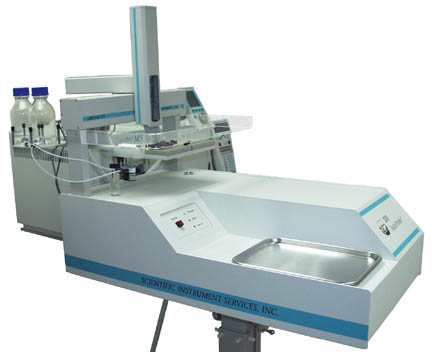
Figure 1 - AutoProbe™ attached to the Thermo Finnigan TRACE™ MS
The AutoProbe™ System from Scientific Instrument Services, Inc. is attached to the Thermo Finnigan TRACE™ MS system. The AutoProbe System is designed to inject samples directly into the MS source. The Thermo Finnigan Xcalibur™ software program is used for the operation of the MS. The AutoProbe software for the operation of the AutoProbe is fully integrated into the Xcalibur software.

Figure 2 - Plug in DEP Probe Tip for the AutoProbe
The AutoProbe uses a plug in Direct Exposure Probe (DEP) tip on the end of the auto injecting probe shaft. The DEP coil is constructed from a 0.005" diameter x 0.375" long piece of pure platinum wire. The coil is spot welded to two stainless steel posts which are connected to two pins which plug into the electrical connectors on the end of the probe shaft.

Figure 3 - DEP Tip attached to the AutoProbe Shaft
Samples for analysis are dissolved in a suitable solvent and 0.125 to 1.0 ul of the prepared sample solution is injected onto the DEP coil on the tip of the probe.
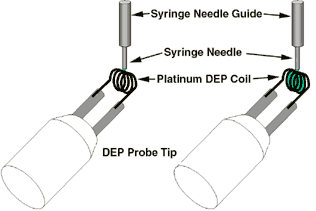
Figure 4 - Loading samples onto the DEP coil
Three levels of temperature control are entered into the AutoProbe method screen in the Xcalibur software. These current values are entered into the screen shown below and stored as part of the Xcalibur method. Temperatures for each of the steps can either be isothermal or programmed at a ramp rate and the value held for a specified period of time in seconds. All values are entered in millamps of DC current and the filament current is measured by the AutoProbe electronics during operation.
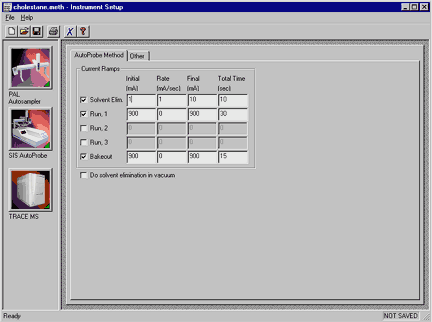
Figure 5 - AutoProbe Method Screen for the input of DEP Probe Current Values
After the sample is loaded onto the DEP coil, a small current is passed through the DEP coil to evaporate the solvent from the sample. This solvent removal step can either be accomplished in air (outside the MS vacuum system) or inside the MS vacuum system (but not in the MS source). This small current is needed to evaporate the solvent but not volatilize any of the sample of interest. Either a constant current or a ramped current can be programmed into the AutoProbe software for this operation. The current required for this step is measured by the AutoProbe electronics and displayed on a PC Window in the Thermo Finnigan Xcalibur™ software program for the operation of the MS.
After the probe has been injected into the MS source, the sample is analyzed by passing a higher current, which was previously programmed into the AutoProbe method screen, to volatilize the sample into the MS source.
As a final step, the DEP probe tip is removed from the MS source (but still in the MS vacuum system) and heated to a higher temperature to totally volatize any remaining sample residue from the DEP coil. This assures that the DEP coil is clean and no carry over or "memory effects" will occur in the next sample analyzed by the AutoProbe.
Experimental
In the three steps of DEP coil heating describe above, only values for the filament current are entered into the setup screens and only the DEP filament current is measured by the AutoProbe software. The actual temperature of the DEP coil is not measured or reported.
This paper demonstrates the use of the Stefan Boltzman equation to determine the temperature of the DEP coil on the AutoProbe. The Stefan Boltzman equation is as follows:
![]()
Where:
-
P = Power dissipated in the filament coil in watts
-
S = the surface area of the filament coil in square meters
-
ϵ = the Boltzman constant 5.67 x 10-8
-
T2 = the temperature of the filament (in degrees K)
-
T1 = the temperature of the environment in which the filament is placed (in degrees K)
This formula determines the temperature of the filament by equating the power (P) emitted by the filament as a function of the surface area of the filament.
The power dissipated by the filament is determined by measuring the current through the filament and then measuring the DC voltage drop across the filament. Both the current and voltage can be measured for the filament when it is operating either in air or in vacuum inside the MS.
![]()
Where:
-
P = Power dissipated in the filament coil in watts
-
V = the voltage drop across the filament in volts
-
I = the current through the filament in amps
The surface area of the filament coil is determined by measuring the diameter and length of the platinum coil used for the DEP coil tip.
![]()
Where:
-
S = the surface area of the filament coil in square meters
-
d = the diameter of the filament wire in meters
-
l = the length of the filament wire in meters
-
(pi) = 3.14
Substituting the components for power and surface area and rearranging the Stefan Boltzman equation to determine the temperature of the filament (T2 ) yields the following equations:

Solving for T24:

Solving for T2 - the filament temperature in degrees K:

For these studies a measured current was passed through the DEP filament coil and the voltage drop across the filament was measured with a DC digital voltmeter. When the probe was in vacuum inside the MS vacuum system, DC current values from 16 milliamp (0.016 amp) up to 1200 milliamp (1.200 amp) were applied to the filament and the voltages measured. More than 20 different current values were measured throughout the specified range. When the probe was in air, DC current values from 16 milliamp (0.016 amp) up to 150 milliamp (0.150 amp) were applied to the filament and the voltages measured. The values measure in air and vacuum were near identical for all current values. The DEP probe could not be taken to higher values in air, because the filament would oxidize in air at temperatures in excess of 300 degrees C. These values for current and voltage were then substituted into the formula above to determine the temperature of the filament at the specified current level. Since the calculated temperature is in degrees K, 273 was subtracted from the calculated values to determine the filament temperature in degrees C.
The following chart displays the values for the temperature of the AutoProbe DEP filament as a function of the filament current when the filament is exposed to air at normal room temperature (20 degrees C). A linear line was approximated to the data for the purpose of developing an easy formula for the determination of filament temperature as a function of filament current. The temperature of the filament can be read from the chart or calculated from the formula in the chart.
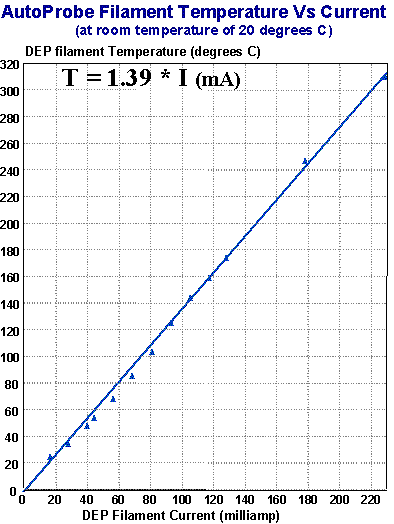
The following chart summarizes this data and can be used to determine the current required to volatilize the solvent from the sample which has been applied to the DEP probe tip at the first step of analysis. These current values can be used in the method screen to set the DEP coil temperature for the solvent removal step. The same currents will achieve this temperature in air as well as in the MS vacuum. However lower temperatures are required to vaporize solvents at the lower pressures in the MS. When the filament is in air, the current through the DEP coil should not exceed 100 milliamps, because this could cause the filament to prematurely burn out due to oxidation of the filament in the presence of oxygen.
|
DEP Coil Temperature (20o C) |
|
| DEP Filament Temperature (degrees C) | DEP Filament Current (milliamps) |
| 40 | 29 |
| 50 | 36 |
| 60 | 43 |
| 70 | 50 |
| 80 | 58 |
| 90 | 65 |
| 100 | 72 |
| 110 | 79 |
| 120 | 86 |
| 130 | 93 |
| 140 | 101 |
| 150 | 108 |
The chart below displays the values for the temperature of the AutoProbe filament as a function of filament current when the filament is in the mass spec vacuum and inserted into the MS source at various source temperature from 20 to 300 degrees C. This chart can be used to determine the DEP filament temperature for any MS source temperature. The curves are not linear over the entire filament current range due to the contribution of the environment temperature to the filament temperature. However at filament temperatures above 700 degrees the plots for all the source temperatures are nearly identical.
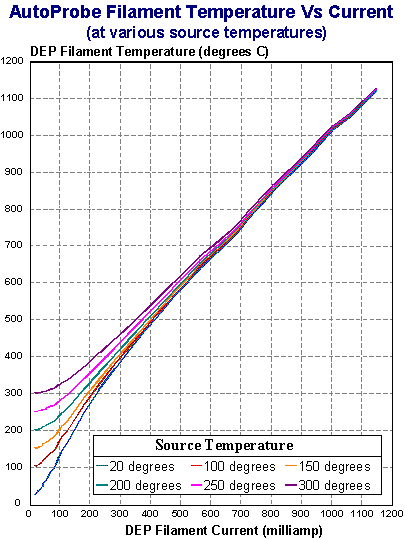
For the above plots, a linear formula could be determined to approximate the temperature of the filaments as a function of filament current. This formula for the plot at 150 degrees C is as follows:
T = 0.886 * I (mA) + 131
However any data calculated with this formula is not exact. Better data for the various source temperatures is more accurately extrapolated from the plots above. The following chart summarizes this data and can be used to determine the current required to use the AutoProbe and to desorb sample analytes off the DEP probe coil and into the MS source. These current values can be used in the method screen to set the DEP coil temperature for the sample analysis step.
|
Selection of DEP Coil Temperature at a 250o Source Temperature |
||||||
| DEP Filament Temperature (degrees C) | DEP Filament Current (milliamps) at a Source Temperature of: | |||||
| 20o C | 100o C | 150o C | 200o C | 250o C | 300o C | |
| 60 | 44 | |||||
| 80 | 60 | |||||
| 100 | 78 | 0 | ||||
| 120 | 90 | 44 | ||||
| 140 | 102 | 70 | ||||
| 160 | 115 | 88 | 40 | |||
| 180 | 130 | 104 | 70 | |||
| 200 | 144 | 122 | 92 | |||
| 220 | 158 | 138 | 118 | 68 | ||
| 240 | 172 | 155 | 135 | 95 | ||
| 260 | 186 | 170 | 152 | 125 | 54 | |
| 280 | 202 | 186 | 170 | 145 | 94 | |
| 300 | 219 | 205 | 190 | 165 | 128 | |
| 320 | 236 | 223 | 210 | 186 | 152 | 90 |
| 340 | 254 | 243 | 230 | 208 | 176 | 128 |
| 360 | 272 | 260 | 250 | 230 | 200 | 158 |
| 380 | 290 | 279 | 270 | 252 | 225 | 186 |
| 400 | 309 | 300 | 290 | 272 | 250 | 215 |
|
Selection of DEP Coil Temperature at a 250o Source Temperature |
||||||
| DEP Filament Temperature (degrees C) | DEP Filament Current (milliamps) at a Source Temperature of: | |||||
| 20o C | 100o C | 150o C | 200o C | 250o C | 300o C | |
| 400 | 309 | 300 | 290 | 272 | 250 | 215 |
| 450 | 362 | 353 | 343 | 325 | 310 | 280 |
| 500 | 412 | 402 | 395 | 383 | 370 | 350 |
| 550 | 464 | 460 | 452 | 442 | 430 | 410 |
| 600 | 518 | 515 | 508 | 500 | 490 | 475 |
| 650 | 572 | 568 | 563 | 558 | 550 | 540 |
| 700 | 631 | 628 | 622 | 618 | 610 | 602 |
| 750 | 690 | 685 | 680 | 678 | 675 | 670 |
| 800 | 748 | 743 | 740 | 740 | 735 | 730 |
| 850 | 808 | 803 | 800 | 800 | 795 | 792 |
| 900 | 868 | 863 | 860 | 860 | 858 | 845 |
| 950 | 928 | 925 | 920 | 920 | 918 | 915 |
| 1000 | 990 | 985 | 980 | 980 | 978 | 975 |
| 1050 | 1060 | 1050 | 1045 | 1045 | 1042 | 1040 |
| 1100 | 1130 | 1120 | 1120 | 1120 | 1119 | 1118 |
| 1150 | 1190 | 1180 | 1180 | 1180 | 1179 | 1178 |
Conclusion
The temperatures of the DEP coil on the AutoProbe can be determined from the measured DEP filament currents. Three different current values are required for the operation of the AutoProbe which can be determined from the data reported above.
(1) Solvent Removal Step. From this data the MS user can select filament current values which will evaporate the sample solvent without desorbing the analytes of interest off the DEP filament wire. Typically temperatures between 40 and 100 degrees C are used for this step which equate to current values between 29 and 79 milliamps.
(2) Sample Analysis Step. For the analysis of MS samples, filament currents can be selected to desorb the analytes of interest off the DEP wire and into the MS source. Excessive temperatures which could pyrolyze the analytes can be avoided. Typically temperatures between 100 and 800 degrees C are selected for this purpose. However the user must take into account the temperature of the MS source when selecting the correct current value to achieve the required temperature of the DEP coil.
(3) Filament Cleaning Step. For the cleaning of the DEP coil after sample analysis, temperatures between 800 and 1200 degrees can be determined to completely remove residues of samples from the DEP wire and thereby avoid cross contamination or "memory effects" in subsequent samples that will be analyzed. Current values between 750 and 1200 milliamps can be used for this purpose. However it must be kept in mind that the higher the temperature, the shorter the filament life. Baking out filaments at currents of 900 milliamp provided a filament life of more than 2000 analysis in our previous studies. Bake outs of more than 1100 milliamps will greatly shorten this DEP filament lifetime.
The AutoProbe technique has been proven to be a quantitative MS injection technique that can reproducibly and quantitatively analyze higher molecular weight samples in about 3 minutes per sample. The technique will be invaluable in the analysis of samples not only in a quality control laboratory but also in a laboratory where high volumes of samples need to be analyzed and quantitated in a short period of time.


